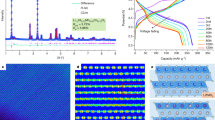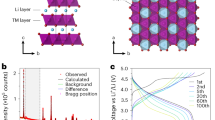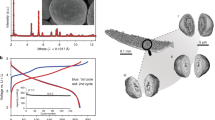Abstract
Voltage fade is a major problem in battery applications for high-energy lithium- and manganese-rich (LMR) layered materials. As a result of the complexity of the LMR structure, the voltage fade mechanism is not well understood. Here we conduct both in situ and ex situ studies on a typical LMR material (Li1.2Ni0.15Co0.1Mn0.55O2) during charge–discharge cycling, using multi-length-scale X-ray spectroscopic and three-dimensional electron microscopic imaging techniques. Through probing from the surface to the bulk, and from individual to whole ensembles of particles, we show that the average valence state of each type of transition metal cation is continuously reduced, which is attributed to oxygen release from the LMR material. Such reductions activate the lower-voltage Mn3+/Mn4+ and Co2+/Co3+ redox couples in addition to the original redox couples including Ni2+/Ni3+, Ni3+/Ni4+ and O2−/O−, directly leading to the voltage fade. We also show that the oxygen release causes microstructural defects such as the formation of large pores within particles, which also contributes to the voltage fade. Surface coating and modification methods are suggested to be effective in suppressing the voltage fade through reducing the oxygen release.
This is a preview of subscription content, access via your institution
Access options
Access Nature and 54 other Nature Portfolio journals
Get Nature+, our best-value online-access subscription
$29.99 / 30 days
cancel any time
Subscribe to this journal
Receive 12 digital issues and online access to articles
$119.00 per year
only $9.92 per issue
Buy this article
- Purchase on Springer Link
- Instant access to full article PDF
Prices may be subject to local taxes which are calculated during checkout







Similar content being viewed by others
References
Lu, Z. & Dahn, J. R. Understanding the anomalous capacity of Li/Li[NixLi(1/3-2x/3)Mn(2/3-x/3)]O2 cells using in situ X-ray diffraction and electrochemical studies. J. Electrochem. Soc. 149, A815–A822 (2002).
Thackeray, M. M. et al. Li2MnO3-stabilized LiMO2 (M= Mn, Ni, Co) electrodes for lithium-ion batteries. J. Mater. Chem. 17, 3112–3125 (2007).
Sathiya, M. et al. Reversible anionic redox chemistry in high-capacity layered-oxide electrodes. Nat. Mater. 12, 827–835 (2013).
Luo, K. et al. Charge-compensation in 3d-transition-metal-oxide intercalation cathodes through the generation of localized electron holes on oxygen. Nat. Chem. 8, 684–691 (2016).
Mizushima, K., Jones, P., Wiseman, P. & Goodenough, J. B. LixCoO2 (0<x≤1): A new cathode material for batteries of high energy density. Mater. Res. Bull. 15, 783–789 (1980).
Padhi, A. K., Nanjundaswamy, K. & Goodenough, J. Phospho-olivines as positive electrode materials for rechargeable lithium batteries. J. Electrochem. Soc. 144, 1188–1194 (1997).
Sathiya, M. et al. Origin of voltage decay in high-capacity layered oxide electrodes. Nat. Mater. 14, 230–238 (2015).
Dogan, F. et al. Re-entrant lithium local environments and defect driven electrochemistry of Li-and Mn-Rich Li-ion battery cathodes. J. Am. Chem. Soc. 137, 2328–2335 (2015).
Hu, E. Y. et al. Explore the effects of microstructural defects on voltage fade of Li- and Mn-rich cathodes. Nano Lett. 16, 5999–6007 (2016).
Xu, B., Fell, C. R., Chi, M. F. & Meng, Y. S. Identifying surface structural changes in layered Li-excess nickel manganese oxides in high voltage lithium ion batteries: A joint experimental and theoretical study. Energy Environ. Sci. 4, 2223–2233 (2011).
Gu, M. et al. Formation of the spinel phase in the layered composite cathode used in Li-ion batteries. ACS Nano 7, 760–767 (2013).
Hong, J. et al. Structural evolution of layered Li1.2Ni0.2Mn0.6O2 upon electrochemical cycling in a Li rechargeable battery. J. Mater. Chem. 20, 10179–10186 (2010).
Reed, J. & Ceder, G. Role of electronic structure in the susceptibility of metastable transition-metal oxide structures to transformation. Chem. Rev. 104, 4513–4533 (2004).
Li, H. Y., Xin, H. L., Muller, D. A. & Estroff, L. A. Visualizing the 3D internal structure of calcite single crystals grown in agarose hydrogels. Science 326, 1244–1247 (2009).
Ruckman, M. W. et al. Interpreting the near edges of O2 and O2 − in alkali-metal superoxides. Phys. Rev. Lett. 67, 2533–2536 (1991).
Palina, N. et al. Electronic defect states at the LaAlO3/SrTiO3 heterointerface revealed by O K-edge X-ray absorption spectroscopy. Phys. Chem. Chem. Phys. 18, 13844–13851 (2016).
Goodenough, J. B. Evolution of strategies for modern rechargeable batteries. Acc. Chem. Res. 46, 1053–1061 (2013).
Lin, F. et al. Surface reconstruction and chemical evolution of stoichiometric layered cathode materials for lithium-ion batteries. Nat. Commun. 5, 3529 (2014).
Yoon, W. S. et al. In situ soft XAS study on nickel-based layered cathode material at elevated temperatures: A novel approach to study thermal stability. Sci. Rep. 4, 6827 (2014).
Aurbach, D., Daroux, M., Faguy, P. & Yeager, E. The electrochemistry of noble metal electrodes in aprotic organic solvents containing lithium-salts. J. Electroanal. Chem. 297, 225–244 (1991).
Browning, J. F. et al. In situ determination of the liquid/solid interface thickness and composition for the Li ion cathode LiMn1.5Ni0.5O4. ACS Appl. Mater. Interface. 6, 18569–18576 (2014).
Yamamoto, K. et al. Improved cyclic performance of lithium-ion batteries: an investigation of cathode/electrolyte interface via in situ total-reflection fluorescence X-ray absorption spectroscopy. J. Phys. Chem. C 118, 9538–9543 (2014).
Qiao, R. M. et al. Distinct solid-electrolyte-interphases on Sn (100) and (001) electrodes studied by soft X-ray spectroscopy. Adv. Mater. Interfaces 1, 1300115 (2014).
Li, Q. H. et al. Quantitative probe of the transition metal redox in battery electrodes through soft x-ray absorption spectroscopy. J. Phys. D 49, 413003 (2016).
Nithianandam, J., Rife, J. C. & Windischmann, H. Carbon-K edge spectroscopy of internal interface and defect states of chemical vapor-deposited diamond films. Appl. Phys. Lett. 60, 135–137 (1992).
Chiou, J. W. et al. Electronic structure of the carbon nanotube tips studied by X-ray-absorption spectroscopy and scanning photoelectron microscopy. Appl. Phys. Lett. 81, 4189–4191 (2002).
Gallant, B. M. et al. Chemical and morphological changes of Li-O2 battery electrodes upon cycling. J. Phys. Chem. C 116, 20800–20805 (2012).
Gauthier, M. et al. Electrode–electrolyte interface in Li-ion batteries: current understanding and new insights. J. Phys. Chem. Lett. 6, 4653–4672 (2015).
Seel, J. A. & Dahn, J. R. Electrochemical intercalation of PF6 into graphite. J. Electrochem. Soc. 147, 892–898 (2000).
Busche, M. R. et al. Dynamic formation of a solid–liquid electrolyte interphase and its consequences for hybrid-battery concepts. Nat. Chem. 8, 426–434 (2016).
Aurbach, D. Review of selected electrode-solution interactions which determine the performance of Li and Li ion batteries. J. Power Sources 89, 206–218 (2000).
Tran, N. et al. Mechanisms associated with the “plateau” observed at high voltage for the overlithiated Li1.12(Ni0.425Mn0.425Co0.15)0.88O2 system. Chem. Mater. 20, 4815–4825 (2008).
Yu, X. Q. et al. Understanding the rate capability of high-energy-density Li-rich layered Li1.2Ni0.15Co0.1Mn0.55O2 cathode materials. Adv. Energy Mater. 4, 1300950 (2014).
Rozier, P. & Tarascon, J. M. Review—Li-rich layered oxide cathodes for next-generation Li-ion batteries: chances and challenges. J. Electrochem. Soc. 162, A2490–A2499 (2015).
Lee, E. S. & Manthiram, A. Smart design of lithium-rich layered oxide cathode compositions with suppressed voltage decay. J. Mater. Chem. A 2, 3932–3939 (2014).
Saadoune, I. & Delmas, C. LiNi1−yCoyO2 positive electrode materials: relationships between the structure, physical properties and electrochemical behaviour. J. Mater. Chem. 6, 193–199 (1996).
Xu, Y. et al. Structural integrity—searching the key factor to suppress the voltage fade of Li-rich layered cathode materials through 3D X-ray imaging and spectroscopy techniques. Nano Energy 28, 164–171 (2016).
Xu, Y. et al. In situ visualization of state-of-charge heterogeneity within a LiCoO2 particle that evolves upon cycling at different rates. ACS Energy Lett. 2, 1240–1245 (2017).
Yan, P. F. et al. Intragranular cracking as a critical barrier for high-voltage usage of layer-structured cathode for lithium-ion batteries. Nat. Commun. 8, 14101 (2017).
Zheng, J. M. et al. Corrosion/fragmentation of layered composite cathode and related capacity/voltage fading during cycling process. Nano Lett. 13, 3824–3830 (2013).
Chen, C. J. et al. The origin of capacity fade in the Li2MnO3·LiMO2 (M=Li, Ni, Co, Mn) microsphere positive electrode: an operando neutron diffraction and transmission X-ray microscopy study. J. Am. Chem. Soc. 138, 8824–8833 (2016).
Kim, H., Kim, M. G., Jeong, H. Y., Nam, H., & Cho, J. A new coating method for alleviating surface degradation of LiNi0.6Co0.2Mn0.2O2 cathode material: nanoscale surface treatment of primary particles. Nano Lett. 15, 2111–2119 (2015).
Qiu, B. et al. Gas–solid interfacial modification of oxygen activity in layered oxide cathodes for lithium-ion batteries. Nat. Commun. 7, 12108 (2016).
Nayak, P. K. et al. Al doping for mitigating the capacity fading and voltage decay of layered Li and Mn-rich cathodes for Li-ion batteries. Adv. Energy Mater. 6, 1502398 (2016).
Hu, E. Y. et al. Utilizing environmental friendly iron as a substitution element in spinel structured cathode materials for safer high energy lithium-ion batteries. Adv. Energy Mater. 6, 1501662 (2016).
Nam, K. W. et al. Combining in situ synchrotron X-ray diffraction and absorption techniques with transmission electron microscopy to study the origin of thermal instability in overcharged cathode materials for lithium-ion batteries. Adv. Funct. Mater. 23, 1047–1063 (2013).
Hu, E. Y. et al. Oxygen-release-related thermal stability and decomposition pathways of LixNi0.5Mn1.5O4 cathode materials. Chem. Mater. 26, 1108–1118 (2014).
Schilling, O. & Dahn, J. R. Thermodynamic stability of chemically delithiated Li(LixMn2-x)O4. J. Electrochem. Soc. 145, 569–575 (1998).
Wang, L., Maxisch, T. & Ceder, G. A first-principles approach to studying the thermal stability of oxide cathode materials. Chem. Mater. 19, 543–552 (2007).
Bak, S. M. et al. Structural changes and thermal stability of charged LiNixMnyCozO2 cathode materials studied by combined in situ time-resolved XRD and mass spectroscopy. ACS appl. Mater. Interfaces. 2014, 22594–22601 (2014).
Kim, J. H. et al. Effect of aluminum fluoride coating on the electrochemical and thermal properties of 0.5Li2MnO3·0.5LiNi0.5Co0.2Mn0.3O2 composite material. J. Alloys Compd. 517, 20–25 (2012).
Kim, H. B. et al. Electrochemical and thermal characterization of AlF3-coated Li[Ni0.8Co0.15Al0.05]O2 cathode in lithium-ion cells. J. Power Sources 179, 347–350 (2008).
Zheng, J. M. et al. Functioning mechanism of AlF3 coating on the Li- and Mn-rich cathode materials. Chem. Mater. 26, 6320–6327 (2014).
Ravel, B. & Newville, M. ATHENA, ARTEMIS, HEPHAESTUS: data analysis for X-ray absorption spectroscopy using IFEFFIT. J. Synchrotron Radiat. 12, 537–541 (2005).
Acknowledgements
We acknowledge the technical support of the beamline scientists J. Bai of X14A, NSLS and S. N. Ehrlich of X18A, NSLS. The work carried out Brookhaven National Laboratory was supported by the Assistant Secretary for Energy Efficiency and Renewable Energy, Vehicle Technology Office of the US Department of Energy through the Advanced Battery Materials Research (BMR) Program, including the Battery500 Consortium under contract DE-SC0012704. Use of STEM at the Center for Functional Nanomaterials of Brookhaven National Laboratory was supported by the US Department of Energy, Office of Science, Office of Basic Energy Sciences, under contract no. DE-SC0012704. The work at the Institute of Physics was supported by funding from the ‘One Hundred Talent Project’ of the Chinese Academy of Sciences, the National Key R&D Program of China (grant no. 2016YFA0202500) and the Foundation for Innovative Research Groups of the National Natural Science Foundation of China (grant no. 51421002). The work carried out at Dongguk University was supported by the Technology Development Program to Solve Climate Changes of the National Research Foundation (NRF) funded by the Ministry of Science & ICT (NRF-2017M1A2A2044502). Certain commercial names are mentioned for purposes of illustration and do not constitute an endorsement by the National Institute of Standards and Technology. J.L. and K.A. gratefully acknowledge support from the US Department of Energy (DOE), Office of Energy Efficiency and Renewable Energy, Vehicle Technologies Office. Argonne National Laboratory is operated for DOE Office of Science by UChicago Argonne, LLC, under contract no. DE-AC02-06CH11357. This research used beamlines X14A, X18A and U7A of the National Synchrotron Light Source, a US Department of Energy (DOE) Office of Science User Facility operated for the DOE Office of Science by Brookhaven National Laboratory under contract no. DE-AC02-98CH10886.
Author information
Authors and Affiliations
Contributions
X.Y. and X.-Q.Y. designed the work; X.Y. and J.L. performed the electrochemical measurements; X.Y. and K.-W.N. performed the hard X-ray in situ XAS experiments; X.Y., S.B., K.-W.N., C.J. and D.A.F. performed the soft XAS experiments; E.H. and X.Y. performed the XAS analysis; S.B. and K.-W.N. performed the thermal experiments. R.L. and H.L.X. performed the STEM experiments and wrote the discussion part related to the STEM experiment. X.B. and J.L. performed the DEMS measurements. E.H. wrote the manuscript with critical input from all other authors; X.-Q.Y., X.Y., H.L.X. and J.L. edited and finalized the manuscript.
Corresponding authors
Ethics declarations
Competing interests
The authors declare no competing interests.
Additional information
Publisher’s note: Springer Nature remains neutral with regard to jurisdictional claims in published maps and institutional affiliations.
Supplementary Information
Supplementary Information
Supplementary Figures 1–16, Supplementary Notes 1–5, Supplementary References
Rights and permissions
About this article
Cite this article
Hu, E., Yu, X., Lin, R. et al. Evolution of redox couples in Li- and Mn-rich cathode materials and mitigation of voltage fade by reducing oxygen release. Nat Energy 3, 690–698 (2018). https://doi.org/10.1038/s41560-018-0207-z
Received:
Accepted:
Published:
Issue Date:
DOI: https://doi.org/10.1038/s41560-018-0207-z
This article is cited by
-
Trapped O2 and the origin of voltage fade in layered Li-rich cathodes
Nature Materials (2024)
-
Achieving a high-performance sodium-ion pouch cell by regulating intergrowth structures in a layered oxide cathode with anionic redox
Nature Energy (2024)
-
Efficient direct repairing of lithium- and manganese-rich cathodes by concentrated solar radiation
Nature Communications (2024)
-
Structurally robust lithium-rich layered oxides for high-energy and long-lasting cathodes
Nature Communications (2024)
-
Mn-based cathode materials for rechargeable batteries
Science China Chemistry (2024)



